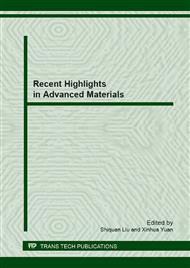p.337
p.341
p.348
p.352
p.357
p.361
p.365
p.370
p.374
Study on Producing Sand-Lime Bricks with Iron Ore Tailings and Phosphogypsum and other Solid Wastes
Abstract:
The paper studied preparing sand-lime bricks by pressure shaping and nature curing, discussed the stimulation effect of compound activators composed of phosphogypsum and lime. The result shows that: when the proportions of raw materials are as follows: 10~15% weight content is iron ore tailings, 3% is phosphogypsum, 5% lime, 5% cement, 40~45% low quality fly ash, and 22~37% chips, the strength of sand-lime bricks produced gets its highest. XRD and SEM are used to characterize its mineral composition and microstructure. The paper also discussed the relationship between structure and performance inside the bricks, and its hydration mechanism.
Info:
Periodical:
Pages:
357-360
Citation:
Online since:
September 2013
Authors:
Price:
Сopyright:
© 2014 Trans Tech Publications Ltd. All Rights Reserved
Share:
Citation:


